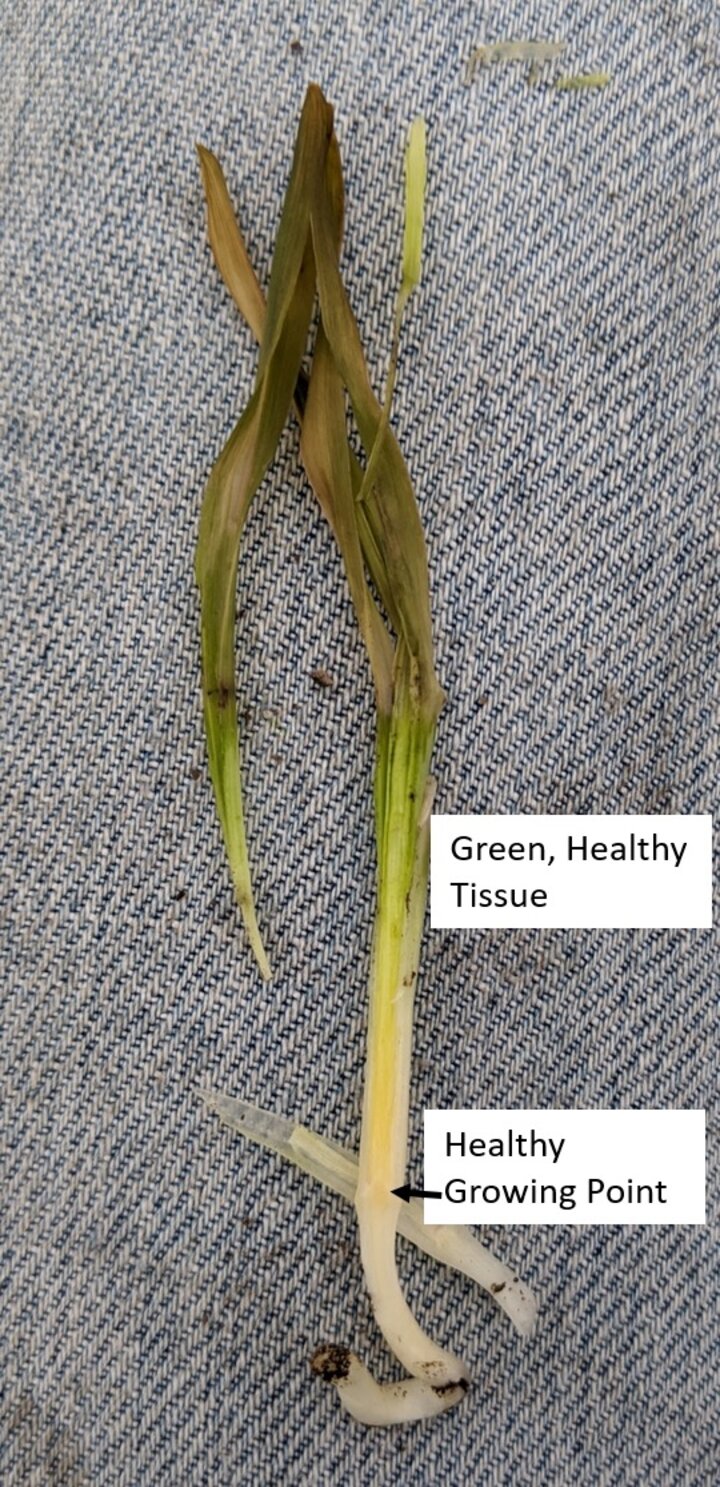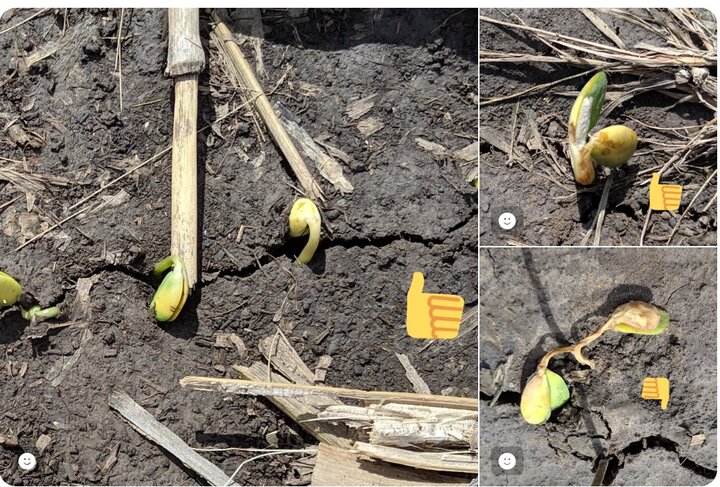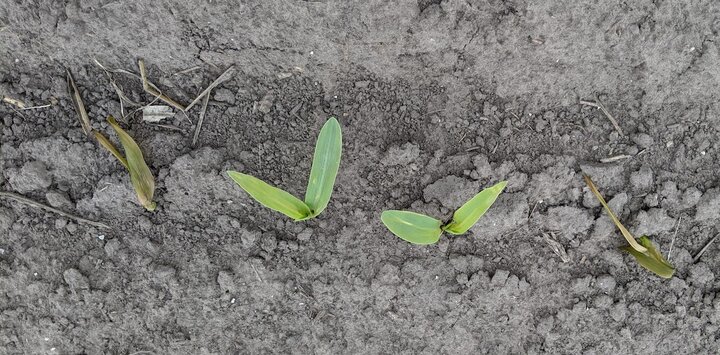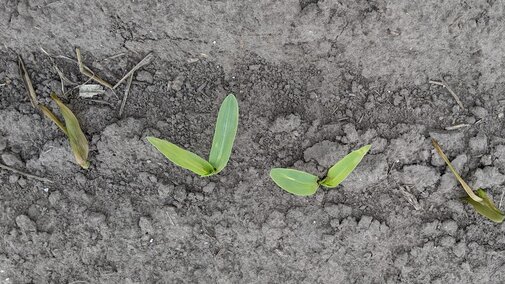The weather has definitely taken a turn to the cold side over the weekend and into this week. Across Nebraska lows at or below 32°F were recorded over the weekend. Clear conditions coupled with temperatures in the 30s can be favorable for frost formation; especially in low lying areas within fields, but can be highly variable. So, what does this mean for our crops?
Plant tissues typically do not freeze when the air temperature around them is 32°F.
The reason is because solutes are present in the membrane-bound cytoplasm (and also just outside of cell membranes) and they act like a very modest anti-freeze. Thus, plant tissue usually does not freeze until the tissue temperature reaches 30°F to 28°F (i.e., -1 to -2C). When you examine the last spring freeze risk probability table, use the 28°F not the 32°F freeze risk.
Source: Pearce, R.S. 2001. Plant Freezing and Damage. Annals of Botany 87:417-424.
Freeze and Chilling Injury in Corn
First off, let’s start with corn. For those of you with emerged corn, remember that the growing point (apical meristem) right now is likely around three quarters of an inch underground in corn and won’t be above ground until around V5-V6. Therefore, any damage to above ground leaves that shows up in the days following injury is unlikely to kill the plant, but may cause superficial damage to young leaves. In this situation, wait 3 to 5 days to evaluate the regrowth of new tissue from the whorl. Injury directly following a frost can appear very severe the day or two days following a frost, but as long as the growing point is unharmed the crop should recover. You can slit open the stems to observe the growing point. A healthy growing point should be yellow/white in color, not brown.
What about corn that hasn’t emerged yet? This depends on when the field was planted. In general, the coleoptile is susceptible to freezing temperature but we would likely need to have temperatures in the mid or lower 20’s for several hours to cause damage so that’s not likely to be a concern with this cold snap. However, when we add the planting timing into the mix, things can change. For fields that were planted just before the cold snap there may be an increased risk for imbibitional chilling due to moisture and soil temperature fluctuations.
As corn seeds take up water the cell membrane stretches and cells expand. When a damaged cell membrane rehydrates, it may not return to its normal shape and size; creating “leaky” cells. This, in turn, is likely to reduce growth rate and interfere with growth of the emerging seedling. Debate exists about what specific temperature and timing causes imbibitional chilling. However, corn plants that imbibe cold water (in the low 40s) in the first 48 hours after planting undoubtedly are affected.

Freeze and Chilling Injury in Soybeans
Now let’s switch to soybeans. Similar to corn, temperatures would have to get very low to damage seedlings still underground that had germinated. If plants have emerged, there are several things going in the soybeans’ favor to avoid damage. First off, our warmer soil temps heading into this cold spell likely helped raise the air temperatures right at the soil surface, which should reduce damage. Secondly, the cotyledons are actually somewhat frost tolerant since they are 95% water and fairly thick, so low temperatures are needed for more time to cause damage. However, soybeans that are just emerging with the hypocotyl hook exposed at or just above ground level, can be the most at risk for damage. The hypocotyl hook is the area of the stem below the soybean cotyledon. Anything that impacts it will result in seedling death. Watch for plants that have soft, mushy, or pinched hypocotyls.
Soybeans that had been planted just before the cold snap are also susceptible to possible damage during germination. Germination for soybeans consists of a quick uptake of water (imbibitional phase), typically less than 24 hours, followed by a slower uptake of water known as the osmotic phase. Chilling during the imbibitional phase can cause severe problems because water is needed to rehydrate the cotyledons and embryo to the point that cell membranes become functional. Cold temperatures interfere with proper hydration of those membranes. The imbibitional phase may complete without chilling injury in cooler soils (45°F) if the soil is moist but not saturated and no cold rains/cold snaps occur within 24 hours.

What about soybeans where the unifoliate leaves are exposed? Unlike corn, once the cotyledons emerge, all of the potential growing points are above ground so damage could occur. However, the key word in this last statement is growing points, as in more than one. So, even if low temperatures damage the stem tip, there are still two more growing points where the cotyledons attach that the soybean could regrow from. While this will set back the plant and cause two stems to form, there is no need to replant if these growing points remained viable.

References
Nielsen, RL (Bob). 2020. Cold Soils & Risk of Imbibitional Chilling Injury in Corn. Corny News Network, Purdue Extension. (Accessed 5/11/2020)
Rees, Jenny. May 10, 2020. https://jenreesources.com/2020/05/10/jenrees-5-10-20/ (Accessed 5/11/2020)
Specht, Jim, Greg Kruger, Jenny Rees, Roger Elmore, Patricio Grassini, Keith Glewen, Tom Hoegemeyer. April 24, 2017. Corn, Soybean Planting Considerations before this Week’s Cold Snap. University of Nebraska CropWatch. Accessed 5/8/2020

